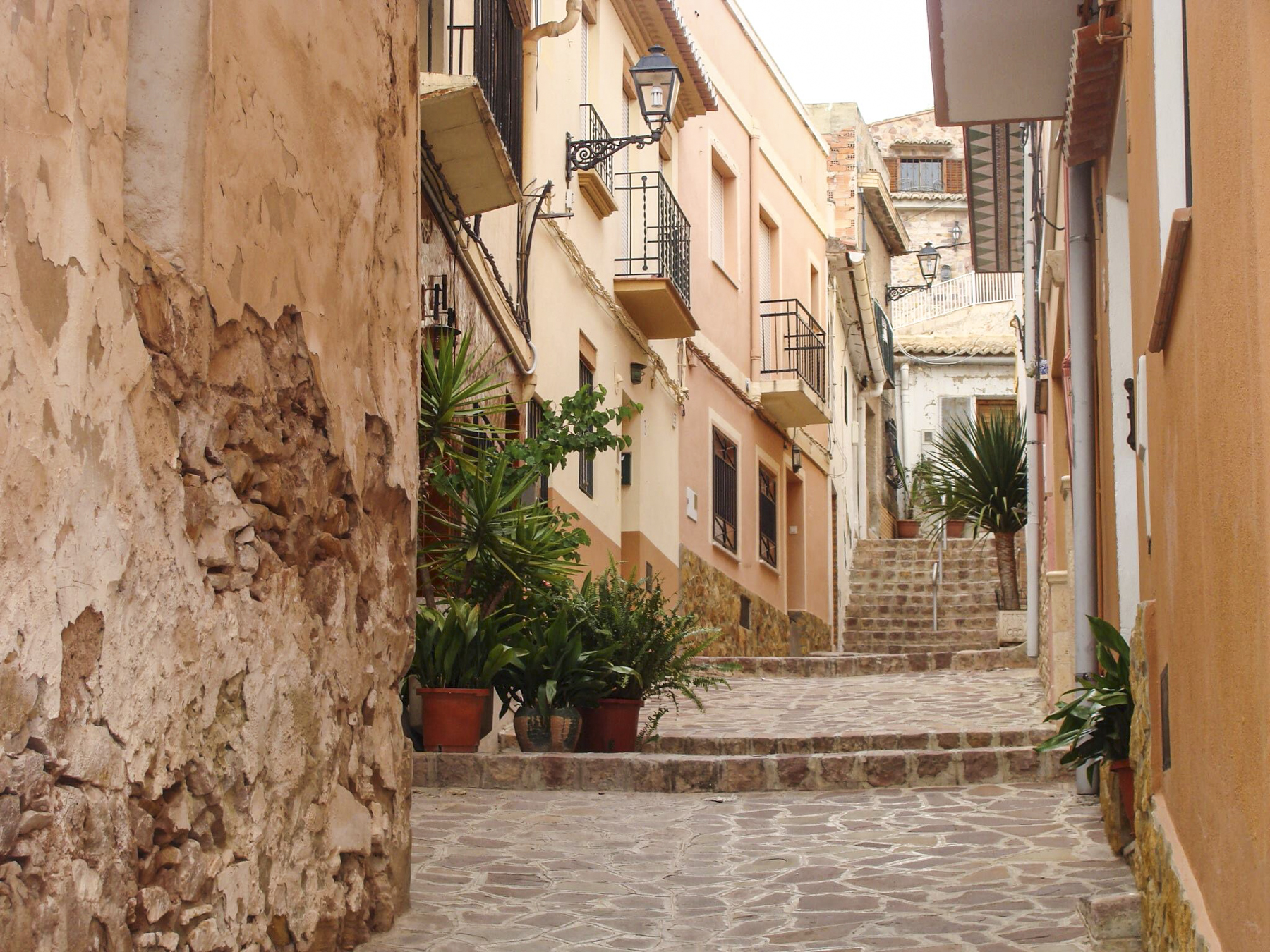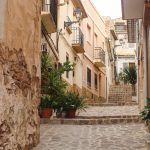A traditional Spanish street. Photo by Rebecca Bumpus.
STORY BY APRIL BARCALOW
I gave my heart and soul to Spain, but not just to the country—rather, I gave them to Valencia. The name itself swells something in me that to this day I cannot adequately define with words. Pronouncing it evokes a sort of ache, as though I’ve both held and lost this eastern swath of Spain. Like the undulating minor keys of flamenco music, the name Valencia calls out a history that was never really mine, and yet is so deeply a part of my childhood that I cannot separate myself from it.
My parents, siblings, and I were foreigners there, interlopers in a long, uninterrupted history of Catholic Spain. We were rare. So rare, in fact, that in 1993 when my aunt came to visit from Holland unannounced, with no address other than the name of our city, she began asking at the far end of town for “the foreigners” and was directed straight to our doorstep.
We were far from typical residents, and yet the Spanish love of hospitality meant our differences were set aside and we were embraced by the warmth of the culture. Life in Spain was lived publicly, predominantly in the main square. Plazas were the heartbeat of every city, pueblo, and neighborhood, pulsating with activity and life. These places welcomed us into community; they were the great equalizers of Spanish social life.
Small shops and bars lined the plazas to meet every possible need: bread, candy, newspapers—and whiskey for the morning coffee. Here neighbors met in the shadow of churches to share news and to discuss current events. Children played games of soccer, passing the ball between the legs of adults out for their walks. Ancianos, their white, wispy hair tucked under black caps, gathered at small tables to slam dominoes down in endless games of chicken foot. Weekly markets appeared and filled the open spaces with booths peddling garlic, artichokes, oranges, and dresses. In these markets Moroccan leather merchants, gypsy farmers, and aging fishermen coexisted seamlessly with Spanish housewives and townspeople. I made some of my first friends in a plaza, playing tag around the center fountain until the wee hours of the morning one hot July night.
In school, my foreign status only seemed to make me more popular. I was a novelty, unique in a mostly uniform demographic, and I never lacked for friends. During recess, we girls gathered in the corners of the paved schoolyard to trade cartas de olor, scented, watercolored stationery that we purchased with pocket change from the local dollar store. We kept our collections in file folders, bartering and trading but never writing on them. They were too precious for that. When we weren’t in school, we met up at parks or in plazas to play games. And because Spanish culture gave us a three-hour lunch break, with time for the main meal and a siesta, we ate supper late at night, often on patios or in the small bars tucked around the perimeter of the plazas.
The Spanish calendar brimmed with festivals of all kinds, and in Valencia none was more important than its festival of Falles, held in commemoration of Saint Joseph, the city’s patron saint and also the patron saint of carpenters. Community centers built massive paper and wood monuments called fallas in the plazas and open spaces of every town. These scenes were beautiful masterpieces satirizing current events or public figures. We walked along with the crowds traveling from plaza to plaza, eating churros dipped in rich chocolate and admiring the enormous structures. Patrons of restaurants and bars spilled out into the streets, the boundaries blurred by the festive atmosphere. Falles included processions of all kinds; one of the most beautiful was the procession of girls, falleras, dressed in traditional costume, parading through the streets to bring flower offerings to the Virgin Mary. They wore shiny brocade dresses, and their hair was pinned in elaborate, braided buns. Gold combs glinted like crowns on their heads.
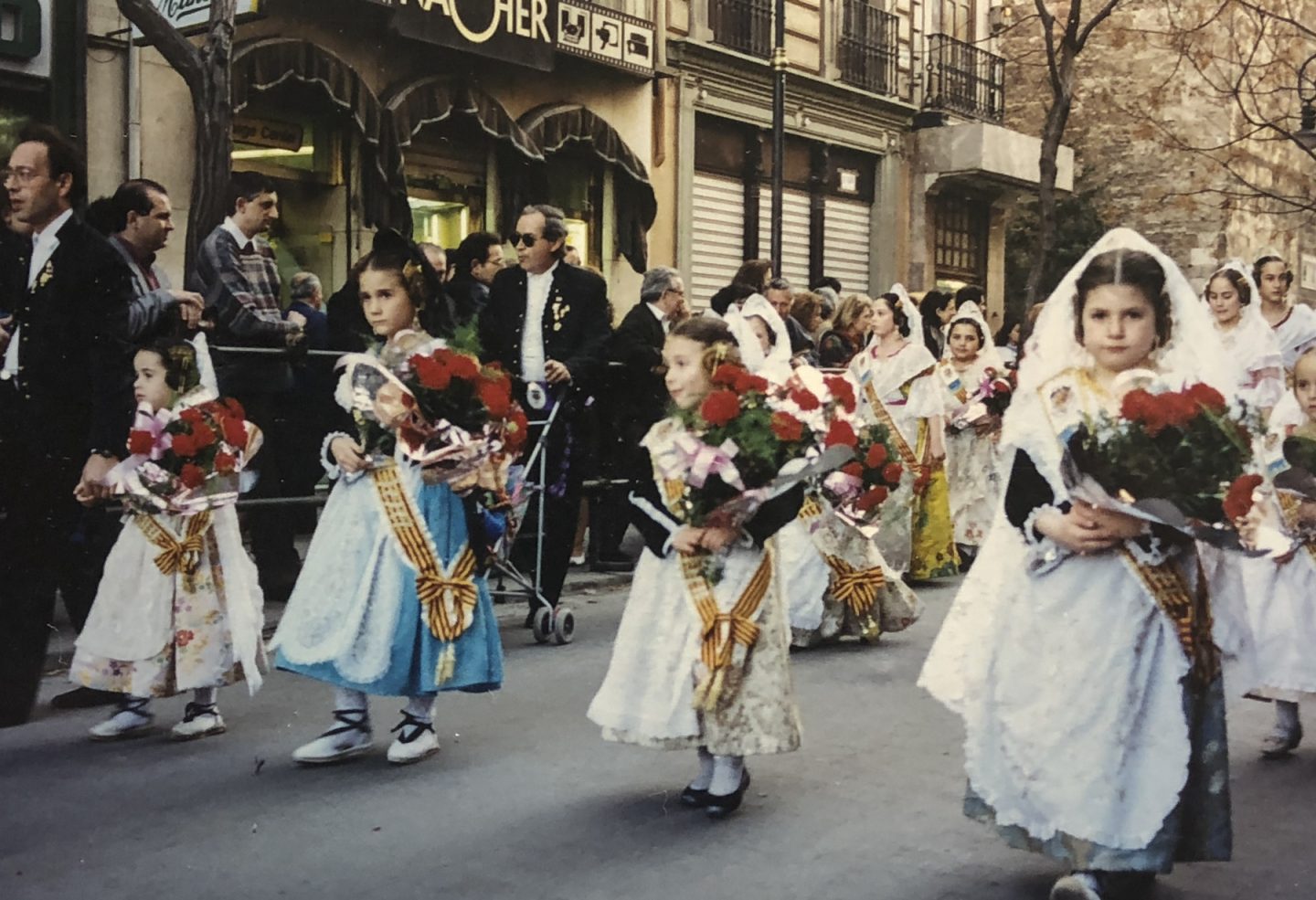
Falleras parading with their offerings for the Virgin Mary. Photo by Jeff Bleijerveld.
Each of my friends took her turn as a fallera. In this experience alone, I was purely an outsider. Though I used to dream of sitting for hours as a team of women dressed me and braided my hair, and though I imagined processing through the streets in all that finery like a bride on her wedding day, becoming a fallera was both a family tradition and an expensive endeavor and never came to fruition for me. Instead, I donned the garb of the crowds that lined the parade routes: a black, buttoned blouse and blue plaid scarf.
Music filled the streets at all hours during Falles, medieval marches played on wind instruments by bands winding through the maze-like streets to the open plazas. The songs, like all of Spanish culture, bore the unmistakable imprint of the Middle East with their minor notes and Moorish rhythms. They were like anthems to me, the songs that defined my childhood.
Lingering in the air between the soul-stirring notes was the smell of gunpowder. School children threw poppers and small fireworks in the streets, and each night the sky was alight with stunning pyrotechnic displays. At midday, we pressed in with the masses gathered in downtown Valencia to witness the mascletà. White, gunpowder-filled pouches were strung across the plaza in front of the city hall. The percussion beat our chests, forcing our hearts to keep pace. The explosions came so steadily that there was no space between the sounds, just a deafening roar. Then, with two final ground-shaking booms!, the square erupted in cheers, drowning out the sound of the bands. We stood mesmerized, held captive by the surreal, shared experience.
The festival gathered momentum with gunpowder, each day building until its culmination on the final night, when we gathered around tables to eat paella, the most popular of all dishes in Valencia. It was never meant to be eaten alone; like most things in Spain, the saffron-infused yellow rice was social at its core. Since cooking it was a job for men, they gathered over low-burning, orange-wood fires for hours as the smell of chicken and rabbit, saffron and garlic wafted from the enormous, round paella pans.
Late at night, we would come together in the plazas filled with fallas. The bands played their music, the notes swelling and falling in the clear night, and the people pressed together as one. Falleras took their place on every balcony, their combs glinting in the streetlights. As the final notes of traditional Valencian songs rang out from trumpets, fireworks burst above us and showered us with paper fragments. The whole sky was ablaze with color and explosive sound. The falla in the center of each plaza was silhouetted against the brilliant night sky.
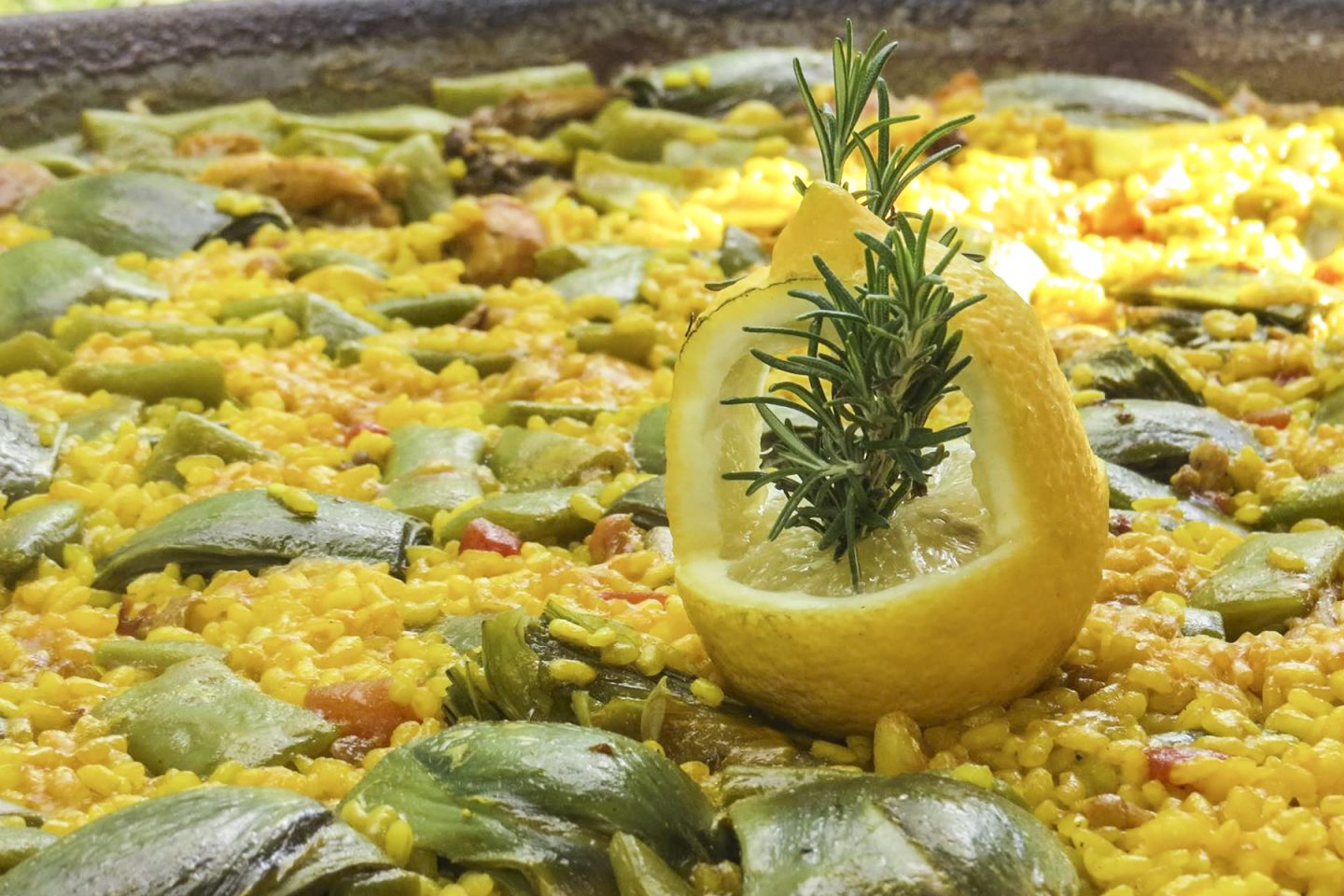
Paella garnished with lemon and rosemary. Photo by Rebecca Bumpus.
Then came the moment that had been building all week: a string of fireworks sputtered and sparked, racing toward the falla. With a smattering of explosions, the monument burst into flames. Falleras wiped tears from their eyes, and we held our breath in the golden light of the flames. There was silence—perhaps the first silence in the whole week of Falles—as the flames reached skyward from the plaza. Then, from the crackling flames rose the soft notes of the clarinet.
The timeless, gripping strains danced like the flames and enfolded us as one body in the embrace of the plaza, uniting me forever to this Valencia of my childhood.

A falla on display in a plaza. Photo by Rebecca Bumpus.
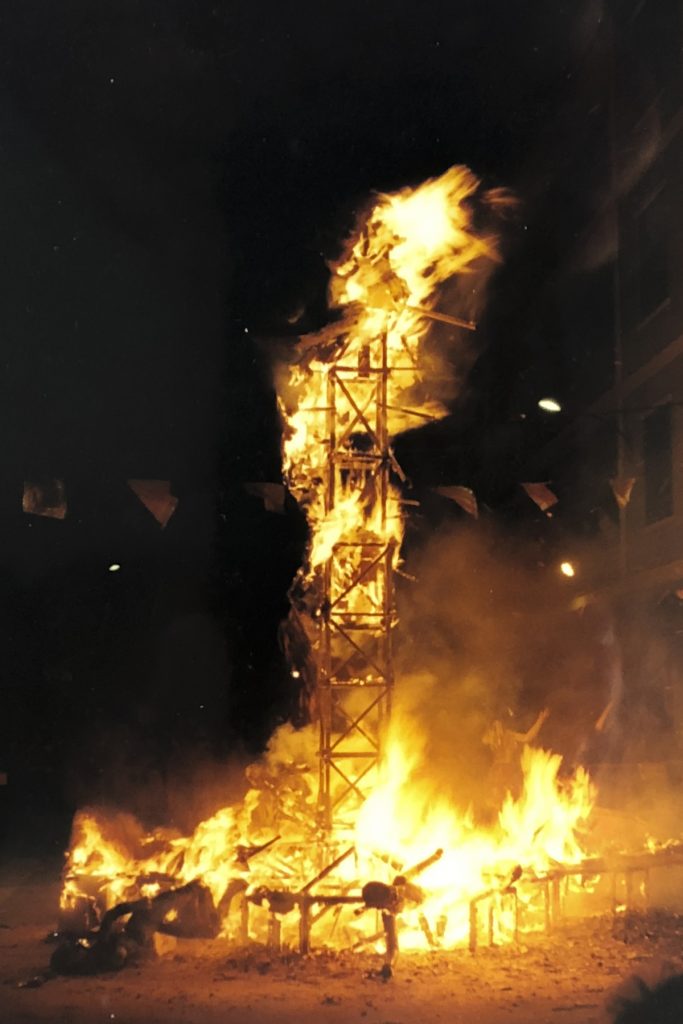
A falla burning on the final night of the festival. Photo by Jeff Bleijerveld.
April Barcalow spent her childhood in Canada, Costa Rica, and Spain before landing in Indiana with her husband and three children. For a decade and a half, she had the privilege of working as a neonatal intensive care nurse tending to the tiniest of patients. She continues to serve as a volunteer nurse in a clinic for underserved people and on a community board for an immigrant and refugee advocacy center. All of these experiences came together to create a passion for diverse cultures, disadvantaged people, and those who are hurting. As a freelance writer, she loves to create stories that invite others to love these people too.

